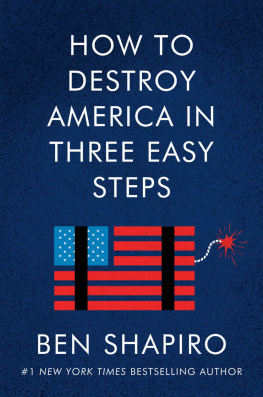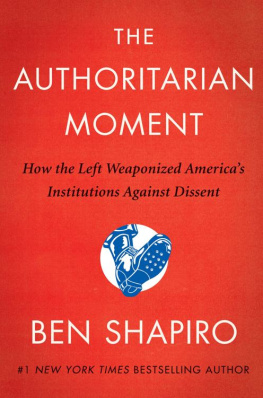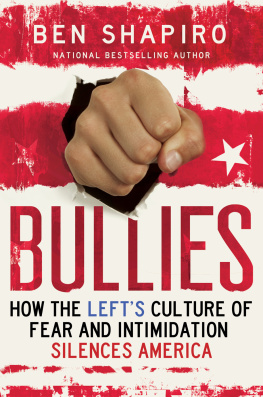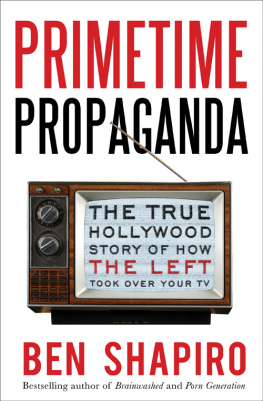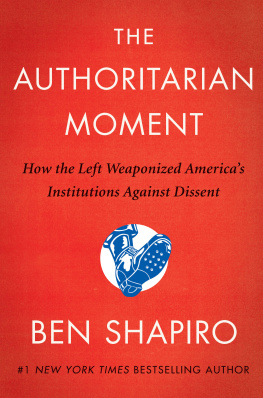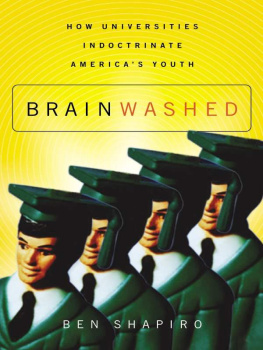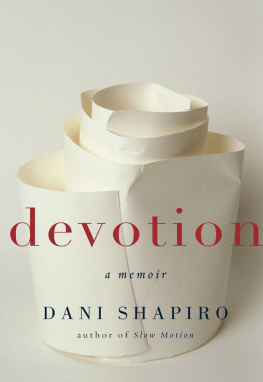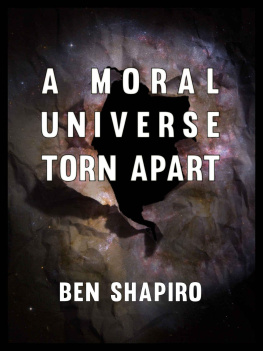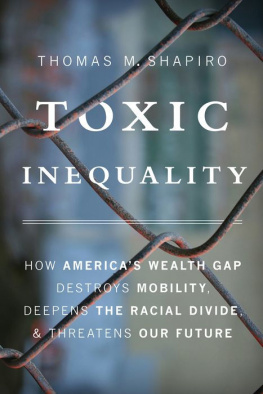Ben Shapiro - How to Destroy America in Three Easy Steps
Here you can read online Ben Shapiro - How to Destroy America in Three Easy Steps full text of the book (entire story) in english for free. Download pdf and epub, get meaning, cover and reviews about this ebook. year: 2020, publisher: Broadside e-books, genre: Science. Description of the work, (preface) as well as reviews are available. Best literature library LitArk.com created for fans of good reading and offers a wide selection of genres:
Romance novel
Science fiction
Adventure
Detective
Science
History
Home and family
Prose
Art
Politics
Computer
Non-fiction
Religion
Business
Children
Humor
Choose a favorite category and find really read worthwhile books. Enjoy immersion in the world of imagination, feel the emotions of the characters or learn something new for yourself, make an fascinating discovery.
- Book:How to Destroy America in Three Easy Steps
- Author:
- Publisher:Broadside e-books
- Genre:
- Year:2020
- Rating:4 / 5
- Favourites:Add to favourites
- Your mark:
- 80
- 1
- 2
- 3
- 4
- 5
How to Destroy America in Three Easy Steps: summary, description and annotation
We offer to read an annotation, description, summary or preface (depends on what the author of the book "How to Destroy America in Three Easy Steps" wrote himself). If you haven't found the necessary information about the book — write in the comments, we will try to find it.
How to Destroy America in Three Easy Steps — read online for free the complete book (whole text) full work
Below is the text of the book, divided by pages. System saving the place of the last page read, allows you to conveniently read the book "How to Destroy America in Three Easy Steps" online for free, without having to search again every time where you left off. Put a bookmark, and you can go to the page where you finished reading at any time.
Font size:
Interval:
Bookmark:
To the founders, who created the greatest country in the history of the world;
to the Americans who struggled and fought to fulfill the promises they made;
and to my children, who inherit the gift of America from all of them.
What holds America together?
That question has, in recent years, taken on renewed urgency. Increasingly, Americans dont like each other. They dont want to associate with one another; they dont want to live next door to one another. More and more, they dont want to share the same country anymore. Red areas are getting redder. Blue areas are getting bluer. According to a November 2018 Axios poll, 54 percent of Republicans believe that the Democratic Party is spiteful, while 61 percent of Democrats believe the Republican Party is racist, bigoted, or sexist. Approximately one-fifth of both Republicans and Democrats consider the opposing party evil.
A 2017 Washington Post poll found that seven in ten Americans thought Americas political polarization is now as severe as it was during the Vietnam War era, reaching a dangerous low point.
All of this is having real-life bleed-over effects. According to Pew Research, 79 percent of Americans believe that we have far too little or too little confidence in each other, and 64 percent believe Americans level of trust in each other has been shrinking.
The center, philosophically and culturally, isnt holding.
As a matter of historic timing, this polarization is odd. The issues that tore America apart over the past centuries have been radically alleviated. Despite the protestations of the liberal media, racism is at an all-time low in the United States; prosperity was, until the coronavirus pandemic, at an all-time high.
We should be happy together.
And yet, increasingly, Americans seem to be looking for a non-amicable divorce. And both sides want the silverware and the dog. From the Right, the outlook for a united America looks grim: conservatives perceive a triumphalist, aggressive Left, hell-bent on rewriting basic American notions, cramming down an extreme vision of identity politics, cheering the demographic change they insist will inevitably result in a permanent political and cultural ascendancy.
From the Left, the outlook for a united America looks similarly grim: Leftists see a reactionary Right, willing to cut any corner in order to maintain their grip on fading hierarchies of power, clutching at the last vestiges of that old order.
These competing visions have defined the Trump presidency. President Trump represents a sort of political optical illusion: Do you see a blue and black dress, or a white and gold dress? Theres no way to see both simultaneously. For those on the Right, Trump represents a seawall against the encroaching, rising tide of radicalism on the Left. His serious character flaws simply become secondary concerns when the future of the nation is at stake. Should Trump lose the presidency in November 2020, conservatives are likely to panic; the potential for national divorce rises dramatically.
For those on the Left, Trump represents confirmation of their worst characterizations of the right: crude, bigoted, and corrupt. The willingness of conservatives to accept Trump, despite all of these flaws, represents further confirmation that the conservative movement was rooted in retrograde impulses papered over with the language of small government. Should Trump win reelection in November 2020, Leftists are likely to panic; the potential for national divorce rises dramatically.
But Trump isnt really the issue, of course. Hes merely the symbol of a broader rift in America that predates his presidency, and has been growing, decade by decade.
In order to heal that rift, we must first try to remember why we got married in the first placeand why weve stayed together all these years.
This is hardly the first time Americans have considered divorce. Indeed, during nearly every major crisis in our history, a contingent of Americans suggest that divorce might be preferable to living together. After all, the logic goes, not all that much holds us togetherAmerica is a marriage of interests, not a love match. When the convenience wanes, the marriage ends. Better that we should go our separate ways, or radically redefine Americanism itselfwhich will end with the same result.
This strain of thought runs from the slaveholding secessionists through the early-twentieth-century political progressives through todays alt-right and identity-politics Left. All of these movements represented a minority of Americans; all had and have outsize influence. The philosophy of division is a philosophy of power politics, a philosophy that paints America as a mythical construct, instituted by those at the top of the hierarchy in order to reinforce their own control. It is a philosophy that derides any notion of American unity as a lie, and bathes that which links usAbraham Lincolns bonds of affection and mystic chords of memoryin acid, disintegrating our ties and casting us all adrift.
Throughout this book, we shall call this strain of thought Disintegrationism.
Then there is another strain of thought. Throughout American history, this strain of thought has emerged victoriousthough never without pain and struggle, and sometimes at the cost of death. This philosophy argues that what unites Americans is far stronger and deeper than what divides us, that our vows to one another were cemented in blood, that we are inextricably intertwined. A separation would kill us both.
This strain of thought runs from the founding fathers through Abraham Lincoln through the civil rights movement. This strain of thought championed reason and universal morality above passion and tribalism, and emerged with a belief in the value of democracy and individual rightsprinciples that were always true, but never properly applied. This strain of thought suggests that America is always an imperfect union, but it is indeed a unionand that we are always in the process of strengthening and growing that union, built on the foundations of founding ideals.
Throughout this book, we shall call this strain of thought Unionism.
Most Americans are Unionists. But they are under attack: steady, unyielding attack by those who support Disintegrationism. Our bonds are fraying. What is left is chaos. Without the ties of Unionism, the center cannot hold. And it isnt.
So, lets get more specific. What, exactly, has allowed America to stay a country? And why should we continue to do so today?
There are three elements that make America America.
First, American philosophy.
The philosophy of the United States rests on three basic principles: first, the reality of natural rights, which preexist government, inalienable and precious; second, the equality of all human beings before the law, and in their rights; and finally, the belief that government exists only to protect natural rights and to enforce equality before the law. American philosophy believes these propositions are self-evident, in the words of the Declaration of Independence. The founders attempted to implement American philosophy through a unique set of institutions. The Constitution of the United States was a compromise document, designed to enshrine American philosophy via a limited government system. That constitutional systems enumerated powers balanced the necessity for action embodied in the legislative power with the necessity to avoid tyranny; the constitutional systems checks effectively balanced the requirement of an executive powerful enough to respond to threats and enforce law with the requirement to avoid despotism embodied in checks and balances; the constitutional systems federalism was constructed to frustrate national schemes to subsume the character of local communities, while simultaneously preventing those local communities from becoming autocracies.
Font size:
Interval:
Bookmark:
Similar books «How to Destroy America in Three Easy Steps»
Look at similar books to How to Destroy America in Three Easy Steps. We have selected literature similar in name and meaning in the hope of providing readers with more options to find new, interesting, not yet read works.
Discussion, reviews of the book How to Destroy America in Three Easy Steps and just readers' own opinions. Leave your comments, write what you think about the work, its meaning or the main characters. Specify what exactly you liked and what you didn't like, and why you think so.

